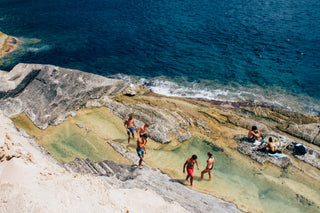The sun is your friend— not your foe.
It strengthens every cell in your body, resulting in better metabolic function, immunity, and even mental health.
But as with most good things, it’s possible to overdo it. And we can’t ignore that.
Let’s take a look at the realities of sunburn, how to prevent it, and what you can do when the damage is already done.
What is a sunburn? How is it different from a tan?
A quick Google search on sun exposure will bring up dozens of articles warning against the dangers of UV radiation and boasting the benefits of sunscreen.
They argue that skin tanning and burning are one and the same: damage.
But this really isn’t the full picture. There is, of course, more nuance than that.
While a sunburn is a sign of oxidative stress, a tan is actually a sign of resilience.
When the skin is overexposed to UV rays, it starts producing more free radicals. And when there aren’t enough antioxidants around to fight them off, free radicals inflame and damage skin cells— leaving behind a painful, peeling sunburn.
A golden tan, on the other hand, is the result of UV-activated melanin in the skin. Melanin is a light-absorbing pigment that protects cells from free-radical damage. (1, 2)
And since melanin is part of the skin’s defense mechanism, a sunburn has the potential to turn into a tan because it can trigger the release of melanin to prevent further damage.
The sweet spot is when your body can slowly build up enough melanin without all the damage that comes with a burn. This can only happen when your body is properly nourished, your skin is saturated, and you practice routine sun exposure.
Why oxidative stress is a problem for your skin and metabolism.
The primary players in oxidative stress are electron-deficient free radicals and reactive oxygen species (ROS). (3)
Both of these unstable molecules are byproducts of normal cellular metabolism and are typically kept in check by antioxidants in the cell that “donate” electrons to make them more stable.
Without enough antioxidants, these highly reactive compounds will go around stealing electrons from other nearby cells (oxidation). This leads to damaged lipids, proteins, and genetic material in the skin, weakening its defenses even further. (4)
A pattern of oxidative stress will eventually show up as a compromised moisture barrier, wrinkles, age spots, disease, and potentially even cancer.
This is why taking a mindful, not fearful, approach to the sun is so important.
Slowing down to listen to your body’s signals is usually enough to determine your personal tolerance.
But considering your age, heritage, geography, nutrition, and skin resilience can also be helpful when deciding how much sun is right for you.
What makes you more susceptible to sunburn and peeling?
Everyone’s situation is unique.
Some find it easy to build a tan, while others are more prone to burning.
Here are some factors that often increase skin sensitivity and your likelihood of sunburn.
- Genetics: If your ancestors lived further from the equator, you’ll naturally have less protective melanin in your cells than someone whose ancestors lived in a sunnier part of the world. (5)
- Immune conditions: A compromised immune system can lead to photosensitivity and skin inflammation. Focus on immune-strengthening foundations like nourishing foods, quality sleep, essential minerals, regular exercise, and fresh air. (6, 7)
- Age: Sunlight is important for healthy development, but little ones haven’t stored up enough melanin in their skin, so they’re far more sensitive to UV rays than older children and adults. Enjoy doses of morning and evening light while prioritizing shade in midday sun.
- Compromised skin barrier: Dryness, itchiness, and inflammation are all signs of barrier breakdown and can make you more prone to getting a bad sunburn.
- Alcoholic drinks: Alcohol can drain the concentration of carotenoids (antioxidants) on the skin, leaving it more vulnerable to oxidation. (8)
- Consuming lots of PUFAs: Unstable polyunsaturated fatty acids, like in seed and vegetable oils, are highly reactive in the body. These fatty acids store up in the tissues and can lead to oxidation when exposed to heat, light, and air. (9)
- Skin sensitizing treatments: Benzoyl peroxide, acids, antibiotics, and synthetic retinoids can mess with your lipid barrier and increase free radicals on the skin— making it even more prone to burning. (10)
How to prevent a sunburn in the first place (inside and out).
While things like genetics and where you live aren't as easy to change, here’s a handful of more flexible factors that make your skin more resilient.
- Diet: Do your best to avoid PUFAs and eat more saturated fats like grassfed suet tallow, raw dairy, and egg yolks to lower your chance of lipid peroxidation on the skin. Antioxidants like vitamins E, A, and K will also help counteract free radicals in the cells. Including enough magnesium and collagen is another effective way to strengthen the skin barrier and help the body properly utilize sunlight.
- Sun tolerance and timing: Stick to morning and evening sun for shorter periods to help your skin adjust. Try to limit heading out into the sun at midday when it’s the strongest. Start low and slow.
- Take breaks or change your position: When it’s not feasible to avoid midday sun, make sure to incorporate sun breaks under a tree or by heading indoors. Sometimes simply changing your position is enough to diffuse the sun’s effect on your skin.
- Supportive skincare: Drop the sunscreen. Studies are revealing sunscreen may actually contribute to oxidative stress on the skin. Focus more on restorative and saturated ingredients like tallow, cacao butter, and jojoba oil that naturally have an SPF of 4-6. Tallow skincare not only filters out some rays but also keeps skin moisturized to encourage tanning. Methylene blue is another powerful antioxidant that absorbs UV rays better than oxybenzone and puts them to good use in the body. (11)
- Aspirin: This age-old medication is shown to decrease prostaglandins in plasma and skin to protect against UVB-induced inflammation and damage in both melanocytes and keratinocytes. (12)
- Stop wearing sunglasses: the unnatural tint may interfere with pupil dilation and melanin production, leaving your skin more likely to burn.
- Protective clothing: When you know you’ll be in the sun all day. Wear fuller-coverage linen clothing and a wide-brim hat to physically block the sun. Don’t stress– just plan ahead.
- Listen to your body: Your skin will tell you when enough is enough. Seek shade or cover up when you start to feel uncomfortable (it really is that simple).
So you already messed up— here’s how to turn a burn into a tan without peeling.
We’ve all been there.
Whether you fell asleep at the pool or just didn’t realize how much sun you were getting. It happens.
Though it may feel like the end of the world— it’s not.
But what you do next could determine whether your skin heals or peels.
Here are some ultra-soothing ways to bring down inflammation, repair potential damage, prevent sunburn peeling, and bring on the tan.
- Instant relief: Taking a cold shower or soaking in a cool oatmeal bath post-sun will decrease blood flow to the skin’s surface and quickly ease the burning sensation.
- Cooling remedies: Following up with 100% pure aloe vera will hydrate skin and help bring down inflammation. It may be tempting to use things like Aquaphor for sunburn, but these petroleum-based products may actually increase your skin’s toxic load and contribute to cellular damage down the line.
- Healing saturated skincare: Nourish the skin with nutrient-rich tallow skincare that mends the moisture barrier and encourages healthy recovery. Stay away from steroid creams or products with synthetic fragrances that could further irritate your sunburn. Sun-basking Fatskn customers love using Purist Body Butter as a post-sun rescue to ward off peeling skin. Your body knows how to heal itself with the right support.
- Reparative treatment: Not only is methylene blue a protective pre-sun ingredient, it’s also extremely healing for post-sun skin. It stimulates mitochondrial respiration to actively repair damaged cells— good news for your sunburnt skin. Fatskn Pre-Sun combines this magical blue dye with other nourishing ingredients for the ultimate pro metabolic suncare tool.
Be smart when it comes to the sun— not afraid.
The sun is so good for you. Just don’t overdo it.
Consistent, gentle exposure with the right pre and post-sun support leads to thriving cells, better metabolic function, and radiant skin.
So the goal should always be to skip the burn and build that gorgeous, glowing, resilient suntan.
.
.
.
As always, while we hope to be a no-nonsense resource, we encourage you to do your own research to find the healthiest options for you and your family.
You can check out our collection of good-for-you, tallow skincare products by clicking the link below. We hope to see you there!
.
.
.
References
- Knight, Megan. “Melanin Production Pathway.” News-Medical.net, 8 June 2018, www.news-medical.net/life-sciences/Melanin-Production-Pathway.aspx.
- Liberti, Davide, et al. “A Melanin-Related Phenolic Polymer with Potent Photoprotective and Antioxidant Activities for Dermo-Cosmetic Applications.” Antioxidants, vol. 9, no. 4, 25 Mar. 2020, p. 270, https://doi.org/10.3390/antiox9040270.
- Nakai, Kozo, and Daisuke Tsuruta. “What Are Reactive Oxygen Species, Free Radicals, and Oxidative Stress in Skin Diseases?” International Journal of Molecular Sciences, vol. 22, no. 19, 6 Oct. 2021, p. 10799, https://doi.org/10.3390/ijms221910799
- Goswami, Soumik, et al. “The Oxidative Damages Caused by Ultraviolet Radiation Type c (UVC) to a Tropical Rodent Funambulus Pennanti: Role of Melatonin.” Journal of Photochemistry and Photobiology. B, Biology, vol. 125, 5 Aug. 2013, pp. 19–25, pubmed.ncbi.nlm.nih.gov/23708058/#:~:text=Data%20suggests%20that%20UV%20radiation, https://doi.org/10.1016/j.jphotobiol.2013.04.008.
- Visconti, Alessia, et al. “Genome-Wide Association Study in 176,678 Europeans Reveals Genetic Loci for Tanning Response to Sun Exposure.” Nature Communications, vol. 9, no. 1, 8 May 2018, https://doi.org/10.1038/s41467-018-04086-y .
- Andersen, Liisa, et al. “Nature Exposure and Its Effects on Immune System Functioning: A Systematic Review.” International Journal of Environmental Research and Public Health, vol. 18, no. 4, 3 Feb. 2021, p. 1416, https://doi.org/10.3390/ijerph18041416
- Harvard Health Publishing. “How to Boost Your Immune System - Harvard Health.” Harvard Health, Harvard Health, 15 Feb. 2021, www.health.harvard.edu/staying-healthy/how-to-boost-your-immune-system
- Sammy, Melissa. “A Dangerous Cocktail: Why Sun and Alcohol Shouldn’t Mix.” MDLinx, 1 Aug. 2019, www.mdlinx.com/article/a-dangerous-cocktail-why-sun-and-alcohol-shouldn-t-mix/lfc-4109 .
- Peat, Ray. “Unsaturated Fatty Acids: Nutritionally Essential, or Toxic?” Raypeat.com, https://raypeat.com/articles/articles/unsaturatedfats.shtml
- https://www.facebook.com/verywell. “Acne Medications That Make You More Sensitive to the Sun.” Verywell Health, 28 Jan. 2022, www.verywellhealth.com/which-acne-medications-cause-sun-sensitivity-15652 .
- Kim, Heon . “The Effect of Sunblock against Oxidative Stress in Farmers: A Pilot Study.” Journal of Biomedical Research, 30 Sept. 2017, https://doi.org/10.7555/jbr.31.20160092 .
- Rahman, Hafeez, et al. “Aspirin Protects Melanocytes and Keratinocytes against UVB-Induced DNA Damage in Vivo.” Journal of Investigative Dermatology, vol. 141, no. 1, Jan. 2021, pp. 132-141.e3, https://www.sciencedirect.com/science/article/pii/S0022202X20316845 .


